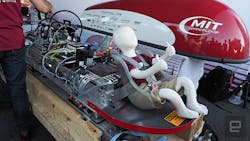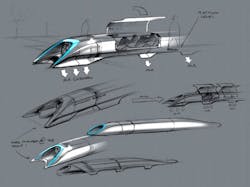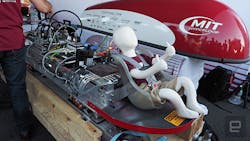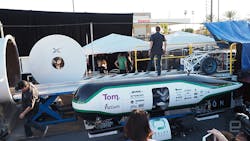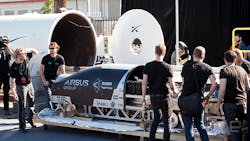Moving Closer to a Hyperloop Reality
Ever since Elon Musk, CEO of Tesla Motors and SpaceX, introduced his ideas for the Hyperloop back in 2013, it has been met with skepticism and harsh criticism. For those unfamiliar, the Hyperloop is a proposed transportation system that uses sealed-off vacuum tubes for a pod to travel 900 miles at speeds up to 760 miles per hour. It was immediately listed as science fiction. Many engineers and transportation experts pointed out the cost and possible engineering problems that would make the Hyperloop an impossible project.
Back in 2013, physicist Dr. Stephen Grande, responded with some of his concerns with the Hyperloop. Air resistance is a major concern. Dr. Grande states that “the faster you go, the more the air piles up in front and the more resistance you get, which means you have to push even harder. And it’s not what we physicists call a ‘linear effect.’” The solution to this problem is to use a vacuum. However, according to Dr. Grande, that brings its own problems. Pumping air out to achieve close to 0% as possible is extremely difficult “because air is wanting to rush back into your tube, and any leak or crack will kill your vacuum.” The Hadron Collider is the largest vacuum tube in the world and has worked tirelessly to achieve its vacuum.
The plan for the Hyperloop is to reduce the atmospheric pressure to 0.1% in the tube. The remaining air will still pile up at the front of the pod, which is why Musk will require the pod to have a fan on the front to consume the air and push it out the back. The pod itself is an issue. They want to reduce the friction the pod will have with the tube. Maglev trains solve this by floating on magnetic fields. The Hyperloop plans to use “air bearings,” which cause the pod to float on a cushion of air. The air comes from the fan at the front of fan.
Dr. Grande voices his concerns on how this will be achieved practically. He comments on how the proposal from Musk “hand waves at the technical challenges of moving the cars from the low-pressure tubes into a station at regular atmospheric pressure. How good are your seals? How much air floods into the system every time you have a car come into the station?” Dr. Grande sums it up succinctly that “Engineering is all about turning ideas into concrete things, and any engineer will tell you that what crazy people like me dream up often can’t be manufactured all that easily.”
Since 2013, several companies and research projects have tried to answer the call set forth by Elon Musk. Companies like Hyperloop One (no association with Musk’s Hyperloop company) and Arrivo have risen to directly answer how a tube tunnel system and transportable pod will be built. Yet, the biggest proof that the Hyperloop concept can become reality took place at the end of January 2017 with the SpaceX Hyperloop Pod Competition. Twenty-seven teams were chosen back in 2016 to build prototype hardware to test their designs at the Hypertube test track. The test track used for the competition was three-quarters of a mile long and 6 feet wide. The internal pressure is 0.02–14.7 psi, allowing for different pod designs to designate the pressure for their different propulsion systems. The max speed limit was set at around 50 miles per hour for the contest. The braking system is based on the pod design as the test track only has an emergency foam pit at the end of a mile. The three different allowed variations of the pod design are either magnetic levitation, air-bearing design based on the original proposal from Musk, or high-speed wheels for speeds less than 100 miles that then are replaced by air bearings for higher speeds.
In order to test the pod in the vacuum chamber, the teams had to pass a 101-point review. These tests included structural, functional, mechanical, navigation, and vacuum checks. It also included an open-air run. Only three teams qualified for the opportunity to test their pods in the Hypertube. These teams were the Massachusetts Institute of Technology, the Technical University of Munich, and the team from Delft University of Technology.
The team that won the overall highest score prize was the pod from Delft University. Their pod—a pill-shaped capsule—used powerful permanent magnets for the levitation, stabilization, and braking system. The overall focus was more on safety and efficiency. The vehicle even included miniature passengers inside the pod to simulate how people would travel down the tube. Even though their pod did not make it to the end of track, their overall concept and approach won over the judges.
The fast pod went to the University of Munich and their WARR Hyperloop pod. Their pod closely resembles a jet engine. It is wrapped in carbon fiber and houses a giant fan in the front to draw in residual air at the front of the tube. By using a powerful compressor, any excess air at the front was pushed out the back to increase forward force. The team did use magnets in their design but right before the run opted to use their high speed wheels. They recorded the top speed at 60 miles per hour (see the video below).
The MIT Hyperloop placed third overall, winning the award for safest and most reliable design. The team at MIT was composed of 35 undergraduate and graduate students from all disciplines including aeronautics, mechanical, electrical, and business management. The video above shows how the magnetic levitation kicks in. Once the wheel stops turning, the maglev system is stabilized to carry the weight of the tube. It reached a max speed of 56 miles per hour before reaching the end of the tube.
The second phase of competition takes place later this summer. The teams will return to the track with lessons learned and improved designs. The advancements being made here are answering a lot of skeptics on whether the Hyperloop system is even possible. Thanks to the engineering spirit of these universities, they have pushed us one step closer from science fiction to reality.
